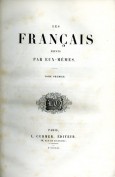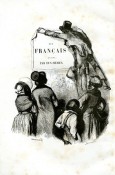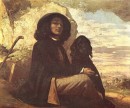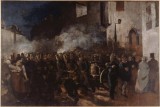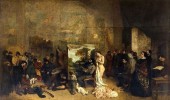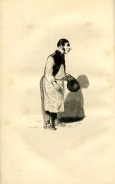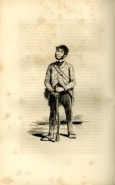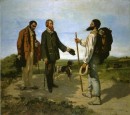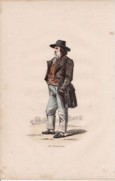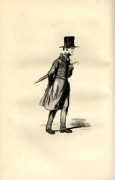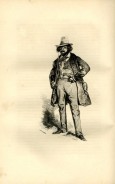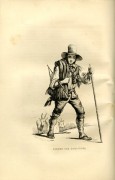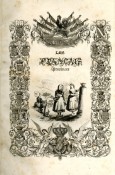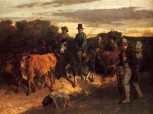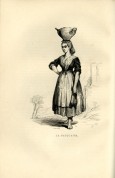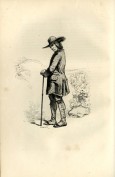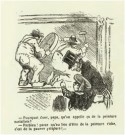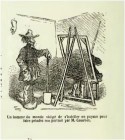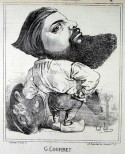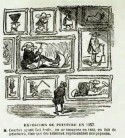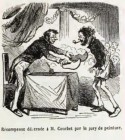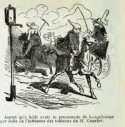The browser will either open the file, download it, or display a dialog.
The discursive influence of the nineteenth-century genre of physiologies, such as Les Français peints par eux-mêmes: Encyclopédie morale du dix-neuvième siècle (figs. 1, 2)[1] has generally escaped the attention of art historians.[2] The Realist painter Gustave Courbet, however, made extensive references to both the techniques of representation and the represented types presented in these texts. In this article I show that Courbet engaged in a socio-cultural discourse articulated in the physiologies which, in turn, aligns him with the Realist writer, Honoré de Balzac. In Balzac’s Human Comedy, characters are described with physical attributes and within locations through which author and reader identified the characters' social status. This method of description and interpretation replicates the verbal-visual hermeneutics of the physiologies and their imaginary functions.[3] In particular, Courbet used the physiologies to both sustain and subvert the rural type as the imaginary “other” of the Parisian hegemony.
This study extends the iconographic scholarship which, beginning with Meyer Schapiro and Linda Nochlin, has established Courbet’s use of popular imagery in the mode of crude (“naïve”) woodcuts. These writers point to specific images and subject matter (folklore and its revival) through which Courbet articulated his political and cultural alliances.[4] Here, I go beyond iconographic analysis to demonstrate Courbet’s participation in the word-and-image dynamic that characterizes Les Français publications. In this article I use this multi-volume publication as both an exemplar of the genre of physiologies[5] and the substance of Courbet’s engagement with the genre. The widespread appeal of the physiologies, in general—particularly for an urban population—can be attributed to their convenient format as illustrated handbooks of contemporary social types. Furthermore, the enduring legacy of physiologies resides in the Realist novels and paintings they spawned. By considering Courbet’s imagery within the realm of the physiologies, I seek to widen the spectrum of visual culture to which his imagery belongs and chart its intersection with the Realist novel, a literary genre that exceeds the populist limitations of “naïve” folklore and traditions. I thus argue that Courbet intercepted a field of reception in which his bourgeois viewers and erudite friends were already skilled de-coders.
To situate Courbet within the discursive space of the physiologies, I begin with a brief snapshot of his own reception of the genre, arriving as a provincial student in Paris. A more in-depth structural analysis follows, explicating how the visual images and verbal rhetoric of the physiologies are inflected in his work of 1849–55, the period in which he most aggressively promoted his Realist agenda. I then position Courbet within a more complex matrix of the social imaginary engendered by Balzac’s physiological mode of writing. I argue that this conflation of the physiologies and Balzac’s provincial novels provided Courbet with a ready-made sign-system for articulating his provincial position contra the Parisian artistic center. In conclusion, I show that the critical reception of Courbet’s work in the guise of the provincial “other” marks the endurance of the physiologies in the collective imagination, despite the end date of their original publication.
Historical Intersections I: Les Français peints par eux-mêmes and Courbet in the 1840s
Briefly considered, Courbet’s early artistic biography parallels the publishing history and popularity of Les Français peints par eux-mêmes. Les Français represents the heyday and codification of physiologies during the early 1840s.[6] The series begins in 1839, when as many as 422 illustrated essays, each treating a single social type, were issued as pamphlets; these were then collected and published in eight volumes between 1840 and 1842. The physiologies' peak years exactly coincide with Courbet’s ten-year residence in Paris as an art student. Arriving in 1839[7] from the Franche-Comté town of Ornans, the young provincial, like others of his type,[8] would have used Les Français to decode the Parisian population and navigate its social spheres. Indeed, the first five volumes were devoted to the urban center. Courbet also used the physiologies to signal his own status among the capital’s ubiquitous student population. In Self-Portrait with Black Dog (1842–44; fig. 3), the young man sports the attire and accessories (aside from his book) identified with the bohemian student culture in which the former provincial took pride: full hair, floppy hat, flaring jacket, windowpane-patterned and light-colored trousers, long-stemmed pipe, and possibly sprouting a moustache and goatee. As Aimée Boutin has shown, similar attributes, which combined a rejection of bourgeois black attire and a taste for tailor-made apparel, were codified by Paul Gavarni’s illustration of L’Etudiant en droit in Les Français peints par eux-même (vol. 1).[9] Ironically, Courbet may have also commented on his own stereotypical provincial-turned-student circumstances ‒ having arrived in Paris as a law student, the novice changes his course of study to pursue a less erudite occupation.[10] At the same time, Courbet recognized the hybridity of his status: at once bohemian-student, rural-bourgeois, and stylish urbanite.[11]
That Courbet had acquired the Parisian physiologiste’s gaze in the 1840s is suggested by his unfinished painting Firemen Running to a Fire (1850-51; fig. 4).[12] As we shall see, the starkly figured array of Parisian types, silhouetted against the urban skyline, evokes a mode of perception and cataloguing typical of the physiologies. Accordingly, T. J. Clark has asserted that “[Courbet’s] intention is transparent: to give us some kind of comprehensive view of Paris, a repertoire of class and types.” Clark’s description of these types itself echoes the rhetoric of the physiologies, in which he identifies the attire associated with the type:
On one side the woman of the people in a russet, sleeveless dress and with a child at her bosom; on the other side, a bourgeois lady on the arm of her husband, swathed in a great grey shawl, her acidulous profile emerging from a grey bonnet embroidered with red flowers. In the middle of the action, the officer is put next to the workman in peaked cap and blue-grey smock; between them there is the impassive, abstracted face of the dandy in a silk hat. And finally the faces of the younger, beardless firemen; already in their half-finished state, sullen and funereal, eyes veiled or averted, the urban counterparts of the Stonebreakers.[13]
Notwithstanding Courbet’s physiologist gaze on Parisian types, Les Français peints par eux-même: Encyclopédie morale du dix-neuvième siècle. Province (hereafter Les Français: Province), comprising the last three volumes of the eight-volume series, would prove more important for his artistic purposes than the Paris guides. In particular, the second volume of the provincial guides would fortify his efforts to de-center Paris as the nexus of French culture and aesthetic standards.[14]
The Physiologist-Artist as Historian
The Artist’s Studio: A Real Allegory Summing up Seven Years of My Artistic and Moral Life (1854-55; fig. 5), provides a starting point for examining Courbet’s active participation in the word-and-image discourse on physiologies. As the title suggests, The Studio represents Courbet’s achievement of his artistic agenda set forth in a letter of 1853: “I alone, of all French artists of my time, had the ability to express and to translate in an original way both my personality and my society.”[15] The painting is also the visual analogue of Courbet’s Realist manifesto published for his 1855 one-man exhibition at the Pavilion of Realism where the Studio was exhibited. As he proclaimed in the manifesto, “my goal” is “to translate the customs, the ideas, the appearance of my time, according to my own estimation; [that is,] to create living art.”[16]
Courbet’s self-assigned task as documentarian, to collect, identify, and classify the social types and mores of his time, echoes the founding premise of Les Français. As stated in the introduction, Les Français fostered a new historicism, aiming to provide a history of contemporary France: “to show ourselves, from head to feet; . . . nothing will be missing from this complete work, whose object is the study of contemporary manners.”[17] Ultimately, Les Français sets out to document the quotidian as a living record for future generations: “We who live today, will one day be posterity. . . . We believe that a day will come when our children will want to know who we were and what we did in those times; how we were dressed, . . . what were our homes, . . . our habits, our pleasures.”[18] The volumes' conclusion underlines the encyclopedic scope of the enterprise: “All the classes of society have been explored, . . . all has been probed.”[19]
Courbet’s description of The Studio echoed the historiographic purpose of Les Français. The Studio, he claimed, “is the moral and physical history of my atelier. . . . It is society at its highest, lowest, and its average; in a word, it is how I see society with its concerns and its passions. It is the world come to be painted.”[20] Likewise, when Courbet described how he divided the painting into two parts, representing distinctive social classes, he echoed the encyclopedic practices of the physiologies. Having gathered thirty-five individuals, he placed “To the right [my] friends, fellow workers and amateurs from the art world. To the left is the other world of trivial life, the people, misery, poverty, wealth, the exploited, the exploiters.” While Courbet identified by name his friends and supporters on the right, he identified the various urban and rural types on the left in a way that mirrors the random collection of types in the physiologies: “A Jew I saw in . . . the London streets, . . . carrying a money-box; behind him is a priest, . . . in front of them a poor withered old man, a republican veteran of '93; next come a hunter, a reaper, a strong-man, a buffoon, a textile peddler, a workman’s wife, a worker, an undertaker, . . . an Irishwoman suckling a child.”[21]
Courbet also articulated the contrasting social groups in the painting’s composition. Visually, the group on the right is harmonized by bourgeois attire and a serpentine line that spatially connects the figures from back to front.[22] This pictorial harmony signifies the alliance of these individuals with Courbet’s own philosophy regarding the social role of art and artists.[23] Conversely, the figures represented on the left are fragments of a society still disharmonious because they have realized neither the transcendent value of work, nor the liberating role that art, freed from academies, plays in the moral progress of society.[24] Thus, with The Studio of 1854-55, Courbet benchmarked his “artistic” coming of age—which, as the painting’s subtitle suggests, began seven years earlier—to coincide with the 1848 Revolution.[25] However, it was upon his return to Ornans in 1849 that the painter first realized his artistic maturity. From this provincial hinterland, Courbet defined his Realist agenda by portraying individual types associated with the Franche-Comté town.[26]
Physiologies and Fragmentation
As we shall see, visual/formal fragmentation of social types, stuck together on the canvas surface, dominate Courbet’s Salon paintings of 1850–51. In these works, fragmentation bears a formal affinity with the format of Les Français. While the visual elements of the Les Français volumes follow a standardized format for each chapter ‒ header illustration, the decorative first letter, and the cul-de-lampe (the decorative design at chapter’s end)[27], full-length figure-types (figs. 6, 7) are injected into the text at apparently random intervals. Sometimes they appear at the beginning of the chapter and sometimes in the middle, fragmenting the narrative.[28] Because of their scale and the detailed rendering of attire and physical bearing, these figures appear as self-contained icons. The full-length figures are also spatially incongruent: sometimes they stand in a void; elsewhere they boldly project from, or are out of scale with, the minimized settings against which they are silhouetted. Designed by different illustrators, the iconic figure-types appear as disjoined vignettes, just as the variously authored chapters function as independent verbal snapshots within the various volumes.
This vignette format is what structures Courbet’s The Meeting or Bonjour, Monsieur Courbet (1854; fig. 8).[29] Showing an encounter between the artist, his patron Alfred Bruyas, and Bruyas’s servant Calas, on a road outside Montpellier, these figures are monumentalized in relation to the terrain in the distance. Like the rural figure-types in Les Français, they appear to be stuck on the landscape scene, rather than spatially integrated with it. Even more striking is the way Courbet appropriates the premise that “clothes make/define the man” from Les Français and adapts it to his social vision. Bruyas and Calas, residents of Montpellier, are identifiable as provincial townsmen by their attire, as seen in Le Forésien (fig. 9), Les Français: Province (vol. 2). Dressed in brown and green coats, and holding soft-fabric hats,[30] these men’s regional identities are distinct from the Parisian bourgeoisie, such as L’Employe (fig. 10) in Les Français peints par eux-mêmes (vol. 1), who are typically dressed in black coat and top hat. Courbet also borrowed specific physiologies from Les Français, but with ironic intent.[31] First, Courbet dressed the servant as L’Ami des artistes (fig. 11) from (the urban) Les Français peints par eux-mêmes (vol. 1), perhaps in reference to his own friend, Francis Wey[32] who authored the essay. However, Courbet transformed Calas’s figure from the buffoonish urban-type shown in Les Français into a respectable townsman and thereby transformed the servant-laborer into an admiring friend of the artist-laborer. According to his social philosophy, Courbet identified with the laborer, seeking a common ground in aestheticized work. Courbet, in turn, signified his own artist-laborer identity by depicting himself in the pose and attire of two laborer types: a peasant worker—as seen in the Berger des Garrigues, Le Languedocien (fig. 12) illustrated in Les Français: Province (vol. 2)—and of the proletarian-flâneur (fig. 13) in Louis Huart’s Physiologie du flâneur (1841).[33] With these personas, Courbet had positioned himself as a rural painter-worker, performing a subversive role within the binary nexus of Paris/province:[34] working from the provinces, he sought to de-center Paris as the site of aesthetic standards and cultural modeling.
Physiologies and the Balzacian Perspective
Both the historicist ethos and the figurative fragment are what join Courbet’s work with the complex exchange between the physiologies and Balzac’s The Human Comedy.[35] As a contributor to Les Français and a self-described “physiologiste,”[36] Balzac was central to the refraction of the physiologies into Courbet’s Realism. Balzac’s physiological writings saturated the market and minds of France’s reading public during the 1840s and for decades after his death in 1850.[37] Most likely, Courbet would count among Balzac’s readers, while his Franche-Comtois and Parisian friends counted among the novelists who adopted Balzac’s physiological writing style.[38] Yet Balzac was not just a participant in the discourse on physiologies, he encoded its sign-system. In addition to writing five essays for Les Français,[39] he independently authored and published single volume physiologies, dating from 1829–48.[40] Most important for tracking this discourse in literature, Balzac wrote The Human Comedy during these same nineteen years.[41]
In Balzac’s megalithic work, comprising 100 linked novels, the physiological methodology runs wide and deep. As he explained in the 1842 preface, The Human Comedy was conceived “to form a complete history of which each chapter was a novel, and each novel the picture of a period. French society would be the real author; I should only be the secretary.”[42] Ostensibly the objective observer, Balzac used the physiologies to identify and categorize, in his novels, disparate human appearances into recognizable social types. Invoking the encyclopedic indices of Les Français in his preface, [43] the author articulates the chaos to which he brings order: “The differences between a soldier, an artisan, a man of business, a lawyer, an idler, a student, a statesman, a merchant, a sailor, a poet, a beggar, a priest, are as great, though not so easy to define, as those between the wolf, the lion, the ass, the crow, the shark, the seal, the sheep, etc.” The physiologies also facilitated Balzac’s cataloguing of social types into a collection of social manners: “By drawing up an inventory of vices and virtues, by collecting the chief facts of the passions, by depicting characters, by choosing the principal incidents of social life, by composing types out of a combination of homogeneous characteristics, I might perhaps succeed in writing the history which so many historians have neglected: that of Manners.” Finally, Balzac underscored his contribution to the physiologies by assigning to each social type a particular cultural and geographic milieu within which their manners are manifest. He thus divided the 100 novels of the Human Comedy into six series headings: “Hence the very natural division into the Scenes of Private Life, of Provincial Life, of Parisian, Political, Military, and Country Life. Under these six headings are classified all the studies of manners which form the history of society at large.”[44]
His claim to nature aside, Balzac’s physiological method activates and augments the social imaginary. Indeed, the veracity of his inventories depended on his reader’s familiarity with the typological system through which the novelist could depict his characters' manners, dress, and milieu as signifiers of their social position. As Balzac admitted in the preface, “These six classes correspond, indeed, to familiar conceptions.”[45] Thus, in his novels, Balzac assumes the dual role of illustrator-writer, providing detailed descriptions of his characters' topographic or furnished settings, facial features, physical bearing, and attire. He likewise narrates the characters' inner, emotional life as it manifests the “passions” of a particular social type. Finally, with this visual detail and verbal density,[46] Balzac circumscribes a narrative space for his characters, so that they function as physiological specimens who perform, and advance the narrative, according to their pre-determined social markers. Indeed, much like the iconic figures in Les Français, Balzac’s characters are rendered static by the weight of their legibility. They interact only insofar as they bring each other into binary dramatic relief.
Balzac extended this binary to Paris and the provinces. As he pronounced in the to The Human Comedy, “Scenes of Provincial Life represented the age of passion, scheming, self-interest, and ambition. Then the Scenes of Parisian Life give a picture of the tastes and vice and unbridled powers which conduce to the habits peculiar to great cities, where the extremes of good and evil meet. Paris and the Provinces ‒ a great social antithesis ‒ held for me immense resources.”[47] Consequently, in “Scenes of Provincial Life” and “Scenes of Parisian Life,” he gave “Each division . . . its local color.” To be sure, these divisions perpetuated the pejorative Parisian myth of the provincial other as the site of boredom, backwardness, and isolation. Such a provincial portrait is rendered in Albert Savarus which, incidentally, takes place in the Franche-Comté capital of Besançon. However, as Andrew Watts has shown, Balzac’s view of the provinces was not so one-sided; his novels shift between negative and positive portrayals. Additionally, Balzac stood at the forefront of a literary rediscovery of provincial France,[48] part of a broader national movement to preserve and restore provincial traditions and monuments.[49] Especially in his later novels, Balzac portrayed the provinces and its inhabitants as guardians of the nation’s traditional values ‒ wholesome simplicity, domestic tranquility ‒ and of nature’s restorative powers.
Historical Intersections II: The Physiologies of Rural Types
This shift in the Paris/province binary, and an attendant ambiguity, is also mirrored in Les Français: Province (fig. 14). In the last three volumes of Les Français the project of cataloguing individual urban types is replaced by a catalogue of “the moral physiognomy of each province.”[50] However, as Ségolène Le Men explains, a shift in style and intention occurs between the first and second volumes of this latter series.[51] The first of the tomes is devoted to the general representative types of the provinces and follows both the format and the frequent satirical voice of the Paris volumes. The individual chapters, authored by Parisian writers, also mirror provincial life as viewed from the Paris center, that of mediocrity and monotony.[52] In contrast, volume two of the province series gives voice to the regionalist movement as well as to issues of the gravity of its mission. Here the editor’s introduction announces a new direction and purpose ‒ “to understand the physiognomy of the provinces, . . . which are erased day by day and will disappear forever.”[53] Therefore, in order to recover ancient values and a national moral unity in the face of the (post-revolutionary) fragmentation of French society and rural industrialization, the second province volume focuses on the peasantry as the embodiment of ancient values, and devotes itself to recording “the traits particular to each province ‒ manners, customs, patois, songs, dances, costumes.”[54]
Its editorial mission notwithstanding, the very structure of Les Français: Province undermines national unity. Twenty-seven provinces are examined in detail by authors who are native to their region. Most notably, Courbet’s close friend Francis Wey wrote the chapter on the Franche-Comté in the second volume of Les Français: Province. While local authorities, such as Wey, lend authenticity to each chapter, their divergent voices rupture a picture of the whole. This regional specificity also pertains to the images of iconic figures inserted in the chapters: each regional type is represented in either traditional or provincial attire and in a setting specific to local topographies and occupations. Balzac’s provincial novels affect a similar disunity and ambiguity. In Scenes of Provincial Life, Balzac explored and extensively documented regional differences for each novel in the series. Given their actual and imagined diversity, the provinces remained both fragmented and fixed as the binary “other” of the Parisian capital.
I now want to show how A Burial at Ornans (1849–50; fig. 15) and Peasants of Flagey Returning from the Fair (1850–55; fig. 16) articulate similar paradoxes that both threaten and sustain the social imaginary about rural France. For one thing, these paintings straddle the gap between Les Français’s mission for national unity and the disunity its format fostered. For another, while Courbet views the Franche-Comtois through the lens of the provinces volumes, he does so not to recover national unity, but to invoke the diversity of contemporary provincial life and its opposition to the capital center.[55]
A Burial at Ornans, exhibited at the 1850/51 Salon, marks, in Courbet’s words, “my debut and my statement of principles.”[56] As suggested by the painting’s official title: Historical Painting of Human Figures, of a Burial at Ornans, Courbet here debuts as a Balzacian physiologiste of provincial customs, habits, and manners. Indeed, the title refers to a commonplace (middle class) ritual that occurred on the outskirts of Courbet’s hometown.[57] The picture’s extraordinary size—10 x 20 feet, traditionally reserved for conventional history paintings—declared Courbet’s intention to document and to historicize his native town and its people. A “historical painting of human figures” also refers to the portraits of the approximately fifty individuals that Courbet had gathered in his studio to represent Ornan’s diverse physiological types. While the diversity of appearances in A Burial is similar to the later Studio painting, here the figures are unified by class, representing Ornan’s bourgeoisie.
Writing to his friend Champfleury while working on A Burial, Courbet listed family and friends and city and church officials who were portrayed in the painting. As he boasted, “Here models are for the asking. Everyone would like to be in the Burial. I could never please them all, I would make quite a few enemies.”[58] These models include: the mayor and his daughter; two elderly men dressed as republican veterans of '93; the curate of Ornans; the beadles, one a shoemaker, the other a vine-grower; and the gravedigger, also a simple vine-grower.[59] Courbet’s inventory of the Ornanians he depicted, and the historical record he intended, suggest that he responded to a specifically artistic articulation of the discourse on physiologies in the form of contemporary portraiture. As expressed in an 1842 Salon review for the well-known magazine L’Artiste, it was hoped that portraiture could “rise to the height of the most important historical documents,” and thereby become “a living history that every generation bequeaths to the generations that come after it.”[60]
While A Burial’s assemblage of Ornanian figures is unified by class, the painting fails to provide a visually unified whole, as recognized by Courbet’s own contemporaries.[61] Indeed, viewers responded to the specificity of individual types through the lens of the physiologies. As one critic from the region (Besançon) observed, “As harmonist and poet, [Courbet] leaves everything to be desired. . . . Perhaps he wanted only to juxtapose on the same canvas different specimens of our mountain population.” This figurative fragmentation is enhanced by Courbet’s technical performance. Each figure is not only individuated by a name and occupation, but each one is individualized by the impasto brushwork that defines his/her corporeal and physiognomic presence. Adding to this fragmentation, the materiality of Courbet’s brushwork renders the figures tangibly rough and coarse.
Both the coarseness of the individuals and the monumental scale for rendering the rural bourgeoisie infuriated and confused critics of the Paris Salon.[62] Their responses, however, reified the Paris/province binary encoded in the Les Français volumes and the provincial novels of Balzac’s The Human Comedy. In fact, most critics were enraged by the figures' physical ugliness which they interpreted as an attribute of their rural class.[63] As one critic put it: “Why come here to show me so obligingly all those loathsome, ugly people, all those ignominious, dirty faces, all those grotesque platitudes?”[64] Champfleury, a frequent visitor to Ornans, responded to these attacks by defending Courbet’s authenticity. “As for the alleged ugliness of the bourgeoisie of Ornans, it has not been exaggerated; that is the ugliness of the province, which is important to distinguish from the ugliness of Paris.”[65] Champfleury’s defense echoed some Les Français: Province writers' social criticism of the rural middle class and their materialist concerns which corrupted peasant morals and values; in the critics' essays these intruders were portrayed variously as decadent, or vulgar, or both.[66] Champfleury, himself a Realist writer, also echoed Balzac’s distinctions between Parisian and provincial vices. The latter, Balzac wrote, characterize “the age of passion, scheming, self-interest, and ambition.”[67]
While Courbet appropriated the facile mapping of the physiologies to assert the complexity of the rural middle class, he also subverted the physiologies' visual codes to portray the changing social structure of the rural population. For nineteenth-century viewers Peasants of Flagey Returning from the Fair, Ornans portrayed another familiar rural event: the peasants returning from the Fair where they have sold their goods or purchased provisions for their own farmsteads or commercial enterprises.[68] Courbet contemporizes and complicates the ritual by portraying social hybrids that prevent a reading of regional unification. Here he assembled country peasants and rural townspeople in a single painting, showing that individual economies rupture communal interests. Thus, among his Salon paintings, Peasants of Flagey is the most fragmented.
In Peasants of Flagey, as in A Burial, each figure is rendered with equal material force and coarseness, and each is physically and emotionally disengaged from the others. Like the iconic figure-types in Les Français, each figure is starkly silhouetted against, and out of scale with, a landscape background. For at least one figure, the peasant woman with a basket on her head (fig. 17), Courbet seems to have borrowed directly from Les Français: Province, rendering her static among the men riding on horseback or striding on foot. Other figures refuse easy identification; they are hybrids within the peasantry. For this type Courbet portrayed his father, the foremost man on horseback who wears a blue smock and a top hat, signifying his double status as both country peasant and bourgeois townsman. The man with the pig is the most disjunctive of the group—he strides along in a different direction than the main group, and although he clearly wears attire of the rural townsman (cf. fig. 18), his backpack and umbrella lack visual coherence and occupational identity.[69]
Although Peasants of Flagey received little critical attention, Pierre Proudhon, a Franche-Comtois (Besançon) socialist and Courbet’s friend, reiterated the Paris/province divide that Courbet’s painting makes real. “Here is rural France, with its indecisive mood, its gentle passions, its unemphatic style, its thoughts more down-to-earth than in the clouds, . . . happy when it can preserve its honest mediocrity under temperate authority.”[70] Just as Balzac’s novels had done, both the painting and the critic participate in Les Français: Province’s mission to preserve peasants' values and traditions, but in so doing, fossilize the peasants' stereotypical forms.
Courbet and the Physiologies' Legacy
As we have seen, both Courbet and his critics engaged the verbal language of the physiologies in describing and interpreting the artist’s Salon paintings. Those critics writing from Paris and its official Salons also invoked the visual language of the physiologies, using caricatures to berate Courbet as a peasant type (figs. 19, 20, 21).[71] Foremost among his attributes, wooden shoes make Courbet’s peasantry immediately legible. In these images, produced throughout the next two decades, Courbet’s caricatured figure mirrored, but in the most pejorative ways, the peasants he had painted: he embodied their coarse and vulgar physiognomies and the equally coarse technique with which they were painted (figs. 22, 23). This reduction of Courbet as a provincial peasant type is codified in the caricatures that date from the 1850/51 Salon, particularly in the virulent attacks on the Stonebreakers (1849). In these caricatures the wooden shoes motif is exaggerated to signify the artist-as-peasant, his aesthetic vulgarity and his association with political/social unrest among the peasants.[72] This pejorative view extends to the correlation of Courbet as a peasant/stone-breaker who vandalizes art, breaks its codes of good taste and standards of value (fig. 24).[73]
These caricatures, like Courbet’s paintings, participate in the discourse on physiologies and ensure their continued usage in popular and highbrow culture. To make this claim is to counter current scholarship on the physiologies, which dates the genre’s demise with the waning of publications in the mid-1840s. However, Balzac’s posthumous popularity that followed his death in 1850, including novelists who adapted his method, testifies to the enduring efficacy of the physiologies in supporting the social imaginary that fixed social types and their legibility. What scholars also overlook is that Les Français was re-published in various editions during the next three decades after their original publication.[74] Finally, for the following generation of painters, the so-called “painters of modern life,” Courbet and his Balzacian practice, provided a model for articulating contemporaneity in the visual language of the physiologies. These artists, such as Edouard Manet and Edgar Degas,[75] drew from the physiologies' visual social coding to portray the myriad population of the modern city. In this alternative history, word and image collude to sustain the social imaginary, an imaginary that shaped Courbet’s artistic practice and critical reception.
Earlier versions of this article were presented as papers at “Fossilization and Evolution,” the 35th Annual Nineteenth-Century French Studies Colloquium, Salt Lake City, Utah (October 2009) and at “The Imaginary,” the 9th Conference of the International Association of Word & Image Studies, Montréal, Canada (August 2011). I wish to thank Aimée Boutin for introducing me to the physiologies, while she and I team-taught a graduate seminar “19th-century Paris: Art & Literature” in spring semester 2009, and for inviting me to present my research on her “Types and Physiologies” panel at the NCFS conference.
Unless otherwise noted, translations are by the author.
[1] According to the WorldCat.org bibliographic record, the first three volumes have title-pages without subtitle as originally printed for these three volumes; these volumes were later reprinted with the subtitle, making them uniform with the subsequent five volumes. WorldCat.org., accessed January 30, 2013, http://www.worldcat.org/title/francais-peints-par-eux-memes-encyclopedie-morale-du-dix-neuvieme-siecle/oclc/4364393&referer=brief_results. I will refer to the first 5 volumes as Les Français peints; the last 3 volumes as Les Français: Province; and the 8 volumes together as Les Français.
[2] Exceptions include the following art-historical studies: Ségolène Le Men, Luce Abélès, and Nathalie Preiss, “Les Français peints par eux-mêmes”: Panorama social du XIXe siècle, exh. cat., Paris: Musée d'Orsay (Paris: Réunion des Musées Nationaux, 1993); Judith Wechsler, A Human Comedy: Physiognomy and Caricature in 19th Century Paris (Chicago and London, University of Chicago Press, 1982), esp. chap. 1, “Parisian Panorama: Codes and Classifications,” in which Wechsler discusses the history of physiognomies in the graphic arts, the influence of physiognomies on the physiologies, and Balzac’s pioneering contributions to the latter genre; and Jillian Taylor Lerner, “The French Profiled by Themselves: Social Typologies, Advertising Posters, and the Illustration of Consumer Lifestyles,” The Grey Room 27 (Spring 2007): 6–35. For later nineteenth-century studies see note 75 below.
A distinction should be made between physiognomy, which concerns the interpretation of character from the form of the facial features and body, and physiologies, wherein social types are encoded by clothing, occupation, and habitual milieu. Christopher Rivers provides an apt distinction between the two modes in his discussion of Balzac’s formulation of physiologie as “a field of study devised by Balzac to put the tools of physiognomy into practice to serve the goals of sociology.” Christopher Rivers, Face Value: Physiognomical Thought and the Legible Body in Marivaux, Lavater, Balzac, Gautier, and Zola (Madison: University of Wisconsin Press, 1994), 115.
[3] For a history of the physiologies and their semiotic functions in nineteenth-century Paris, see Richard Sieburth, “Une idéologie du lisible: Le phénomène des 'Physiologies,'” Romantisme 15, no. 47 (1985): 39–60. See also Natalie Bassett, “Les Physiologies au XIXe Siècle et la mode: De la poésie à la critique,” L’Année balzcienne (1984), 157–72, in which Bassett surveys the proliferation of the genre and the varieties of social types and practices the physiologies treated. More recently, scholars have critiqued the physiologies from a “panoramic” perspective, a term coined by Walter Benjamin in the phrase “panoramic literature” in “Paris of the Second Empire in Baudelaire,” in Walter Benjamin, The Writer of Modern Life: Essays on Charles Baudelaire, ed. Michael William Jennings (Cambridge, MA: Harvard University Press, 2006), 66–67; for this Benjaminian perspective see Nathalie Preiss & Valérie Stiénon, “’sketched by Themselves': The Panorama Tested by the 'Panoramic,'” Interférences littéraires/Literaire interferenties, no. 8 (May 2012): 17–24, accessed January 7, 2013, http://interferenceslitteraires.be/sites/drupal.arts.kuleuven.be.interferences/files/illi8introductioneng.pdf.
[4] See Meyer Schapiro, “Courbet and Popular Imagery: An Essay on Realism and Naïveté,” Journal of the Warburg and Courtauld Institutes 4, nos. 3-4 (April, 1941-July, 1942), 164–91; and Linda Nochlin, “Gustave Courbet’s Meeting: A Portrait of the Artist as a Wandering Jew Art Bulletin 49, no. 3 (September, 1967): 209–22. The importance of the physiologies to Courbet’s Realist projects adds another dimension to the contemporaneity of Courbet’s artistic choices. Accordingly, my approach bears a methodological and conceptual affinity with Ting Chang’s “Hats and Hierarchy in Gustave Courbet’s The Meeting,” Art Bulletin 86, no. 4 (December, 2004): 719–30, http://www.jstor.org/stable/4134460. As Chang explains, her “essay suggests that the intersection of the linguistic and the visual produces a web of meanings thus far unexplored in Courbet’s canvas.” She thus interweaves a broad spectrum of “French proverbs and expressions to show that complex significations of class, subservience, ridicule and sovereignty clustered around such details in the painting as hats, beards, and canes.” (emphasis added; article abstract, at 719).
[5] As present-day scholars have established, Les Français was in the vanguard of the genre of physiologies for its comprehensiveness, its word-and-image format, and its widespread distribution. Its publisher-editor, Léon Curmer, conceived the 8-volume set as an “encyclopédie morale du XIXe siècle” (moral encyclopedia of the 19th century), the series' subtitle. See Pierre Bouttier, “Préface” to Léon Curmer and Pierre Bouttier, eds., Les Français peints par eux-mêmes: Encyclopédie morale du dix-neuvième siècle (1839–42; repr.,Paris: Omnibus, 2003), i-iv; and Ségolène Le Men, “Peints par eux-mêmes,” in Le Men, Abélès, and Preiss, “Les Français peints par eux-mêmes”: Panorama social du XIXe siècle, 1–4.
[6] One contemporary account calculated 427 physiologies published in the first half of 1841, with another 3000 scheduled for the second half the year. Bassett, “Les Physiologies au XIXe Siècle et la mode,” 157n2. For additional statistics regarding publication and distribution, see Sieburth, “Une idéologie du lisible,” 46–47.
[7] For a chronology of Courbet’s life see “Key Dates,” in James Rubin, Courbet (London: Phaidon, 1997), 336–39.
[8] As Ségolène Le Men states, the physiologies, and especially Les Français, were used as guidebooks by both foreigners and provincials visiting Paris; “Peints par eux-mêmes,” 20.
[9] Aimée Boutin, “‘The Title of Lawyer Leads Nowhere!’: The ‘Physiology’ of the Law Student in Paul Gavarni, Emile de la Bédollierre and George Sand,” Nineteenth-Century French Studies 40, nos. 1-2 (Fall-Winter 2011-2012): 65–66. As Boutin observes (61), this contradictory set of sartorial choices are also satirized in Louis Huart, Physiologie de L’étudiant, illust. Louis-Joseph Trimolet and Théodore Maurisset (Paris: Aubert et Cie., 1841); and Gavarni’s Les Etudiants de Paris, which includes 60 lithographic plates dating from 1839–42, that first appeared in Le Charivari in the late summer of 1839, and were later collected in Le Diable à Paris (Paris: J. Hetzel, 1845–46).
[10] That Courbet goes to Paris to study law, and abandons his professional studies to become an artist or writer, follows a conventional “script” of the student type arriving in Paris from the provinces. See Gavarni’s illustration for “L’Etudiant en droit,” in Les Français peints par eux-mêmes, 1:17; and Huart, Physiologie de L’étudiant, 4. However, Courbet’s academic situation closely parallels the actual experiences of provincial law students in Paris, as Boutin has characterized the type’s aspirations and disillusions, in “The ‘Physiology’ of the Law Student,” 58. Boutin also examines how the physiologies of the law student were written and illustrated with an ironic sense of the disparity between expectations and realities of the profession, which she illustrates, at 71–76, by way of George Sand’s Horace (1840). In Sand’s novel the anti-hero is the stereotypical student who arrives from the provinces to go to medical school and changes his mind to become a writer, among other “leisurely” professions. Courbet’s frequent letters to his parents, requesting money to pay for fashionable clothing, is another marker of the provincial-Parisian student, as personified in Sand’s protagonist Horace.
[11] See James Rubin, who compares Courbet’s fashionable attire to the dandy, whose fashion and aloofness Courbet and his bohemian friends both adapted and parodied. Rubin, Courbet, 15–16, 21–22. Gavarni’s depictions of young men and artists wearing plaid pants populate the pages of Les Etudiants de Paris. Heidi Brevik-Zender, historian of nineteenth-century fashion, cites fashion plates of the period which featured “stylish middle- and upper-class men in patterned pants.” Personal correspondence with author, January 3, 2012. See, for example, “Three Gentlemen” (August 1843), Fashion Plate Collection, 19th Century, Claremont Colleges Digital Library, accessed January 3, 2012, http://ccdl.libraries.claremont.edu/cdm/singleitem/collection/fpc/id/628/rec/5. Accordingly, Brevik-Zender speculates, “Even if the sartorial look here is deliberately trying to evoke the country (the wide hat brim that provides shade from the sun, the walking stick), on the other hand, the sharp white collar and cuff, the shiny lining and straight seams of the cape, the neatly buttoned vest: these details emphasize the impeccable tailoring of the garments and move away from notions of the rural, the informal, or manual labor.” Personal correspondence with author, January 3, 2012.
[12] The term “physiologiste” was coined by Balzac; see Rivers, Face Value, 115. Nochlin, identifies the visual sources for Firemen Running to a Fire: Rembrandt’s Night Watch (1642); the woodcut illustrations of firemen and incendiary events represented in popular broadsides; and the more upscale illustrated newspapers that depicted these scenes with more realistic wood engravings. Nochlin, “Courbet’s Meeting,” 212.
[13] T. J. Clark, Image of the People: Gustave Courbet and the 1848 Revolution (Berkeley: University of California Press, 1999), 129–30.
[14] The three volumes that constitute Les Français: Province are numbered separately from the first five volumes of (urban) Les Français peints par eux-mêmes and arranged by theme and region: vol. 1 treats provincial social types; vol. 2 treats the provincial regions within the French continental borders; and vol. 3 treats the colonies.
[15] Courbet to Alfred Bruyas, Ornans, October [?] 1853, in Petra ten-Doesschate Chu, ed., Letters of Gustave Courbet (Chicago: University of Chicago Press, 1992), 116.
[16] Courbet, “The Realist Manifesto,” trans. in Linda Nochlin, Realism and Tradition in Art, 1848–1900, Sources and Documents (Englewood Cliffs: Prentice-Hall, 1966), 33–34. The Pavilion of Realism, for which a brochure—Exposition et vente de 40 peintures et 4 dessins de Gustave Courbet (Paris, 1855)—was published, was located outside the 1855 Universal Exposition; the preface to this brochure was titled “Realism,” which later historians dubbed “Realist Manifesto.”
[17] “Nous nous montrerons à eux non pas seulement peints en buste, mais des pieds à la tête et aussi ridicules que pourrons nous faire; . . . rien ne manquera à cette œuvre complète, qui a pour objet L’étude des mœurs contemporaines.” Jules Janin, introduction to Les Français peints par eux-mêmes (Paris: Curmer, 1841), 1:xvi.
[18]. “Nous voulons seulement rechercher de quelle façon il faut nous y prendre pour laisser quelque peu, après nous, de cette chose qu'on appelle la vie privée d'un peuple; car malgré nous, nous qui vivons aujourd'hui, nous serons un jour la postérité. . . .Un jour viendra où nos petits-fils voudront savoir qui nous étions et ce que faisions en ce temps-là; comment nous étions vêtus; . . . quelles étaient . . . nos habitudes, nos plaisirs [etc.].” Ibid., iv–v.
[19] “Toutes les classes de la société ont été explorées. . . tout a été sondé.” Léon Curmer, Les Français peints par eux-mêmes: Province (Paris: Curmer, 1842), 3: 457. As previously noted, the province volumes of Les Français were numbered separately from urban volumes 1–5. Therefore, Curmer’s closing statements quoted here mark the end of the completed 8-volume publication.
[20] Courbet to Champfleury, Ornans, November-December 1854, in Chu, Letters, 131. Because of the affinities between Courbet’s rhetoric and the physiologies, I have replaced Chu’s translation of the word L’histoire as “tale” (in “C'est L’histoire morale et physique de mon atelier”) with “history,” as in Rubin, Courbet, 139.
[21] Courbet to Champfleury, Ornans, November-December 1854, in Chu, Letters, 131. Chu has also related the “random placement of the figures on the left” with “the so-called [early nineteenth-century] physiognomies, or types.” Petra ten-Doesschate Chu, The Most Arrogant Man in France: Gustave Courbet and the Nineteenth-Century Media Culture (Princeton: Princeton University Press, 2007), 70, 72. Courbet continues in the letter to Champfleury by naming his friends—writers, political activists, patrons—on the right: “Promayet with his violin . . . Then behind him are Bruyas, Cuenot, Buchon, Proudhon; . . . Next to [Champfleury (seated)] . . . closer to the foreground is a woman of the world and her husband, both luxuriously dressed. Then towards the extreme right . . . is Baudelaire reading a large book.”
[22] Rubin also “reads” Courbet’s attire in the Studio (green jacket and brown trousers), as a sign of his social status as a “successful bourgeois, rather than a lowly artisan;” Rubin, Courbet, 152. Apparently, Courbet appropriated this class signifier from his bourgeois patron, Alfred Bruyas, who is dressed in similar attire, including the green striped collar of his jacket in The Meeting; see Sarah Lees, Michel Hilaire, and Sylvain Amic, Bonjour, Monsieur Courbet!: The Bruyas Collection from the Musée Fabre, Montpellier, exh. cat. (Paris: Réunion des Musées Nationaux, 2004), 113.
[23] For a discussion of how Courbet adapted Proudhon’s social philosophy to his own artistic program, see Rubin, Courbet, 147–52; and Rubin’s in-depth study, Realism and Social Vision in Courbet & Proudhon (Princeton: Princeton University Press, 1980).
[24] According to Rubin, Courbet placed himself in the center of The Studio, painting a landscape which functions as a claim to his authenticity and his truth to nature. Both the landscape painting and the painter at work on his canvas signify the physical object produced by manual labor and, thereby, a sign of the redemptive/transcendent power of aestheticized labor. Rubin, Courbet, 150.
[25] While Courbet would likely want to identify with the political avant garde in 1855, T. J. Clark has established that the artist did not physically participate in the 1848 Revolution, and at that time his politics were ambiguous. Clark further argues that “the seven years of my artistic life” in The Studio’s subtitle marks, in Clark’s words, the artist’s bidding “farewell to the past” following the “open” Salon of 1848 where Courbet exhibited ten works dating from as early as 1841. Clark, Image of the People, 49–50.
[26] At the 1849 Salon, Courbet exhibited the large-scale painting of family and friends titled After Dinner at Ornans (1848-49), for which he received a gold medal, as well as landscapes showing sites near his home, thereby “displaying his origins.” Rubin, Courbet, 43–44.
[27] See Le Men, “Peints par eux-mêmes,” 6.
[28] As Sieburth observes, the figures are also disjoined from their textual settings, making it difficult to determine whether the text comments on the image or the image comments on the text. Sieburth, “Une idéologie du lisible,” 54.
[29] See also the silhouetted figures and vignette composition of The Wrestlers (Museum of Fine Arts, Budapest, 1852–53). The wrestlers' stocky anatomical proportions, and especially the lower half of the body and stance of the wrestler on the right, are very similar to the physiologie of the wrestler (by Charlet) in Les Français: Province, 1:n.p. Rubin identifies an equally viable source, a woodcut of a wrestling match from Edmund Texier’s Tableau de Paris (1852), which may have also been spawned by the same physiologie type. Rubin, Courbet, 112–13.
[30] See Chang’s description of clothing and hats in “Hats and Hierarchy,” 722. As Chang shows, Courbet’s depiction of dress, accessories (hat and walking sticks), stances, and gestures in The Meeting are each encoded with manifold significations, concluding that “[the] simultaneous legibility and illegibility [of these codes] . . . provided an alternative, secret narrative in the painting,” in which the hierarchies between painter, patron, and servant were ambiguated and remain(ed) unresolved,” 726, 728.
[31] Petra Chu has cogently argued that Courbet used irony as a visual rhetoric in his major Salon paintings of the 1850s, “allowing him to make powerful, even controversial visual statements in indirect and ambiguous ways.” Chu, Most Arrogant Man, 77–78. I especially commend Chu for identifying ironic strategies in Courbet’s works. Her work lays the groundwork for further consideration of Courbet’s ironic use of the physiologies, which were also written with ironic intonations. See Boutin, “‘Physiology’ of the Law Student,” 59–60; and Rivers, Face Value, 112–17.
[32] Rubin, Courbet, 13.
[33] As is well known, Nochlin identified popular imagery of the Wandering Jew as the formal and iconographic source of Courbet’s composition and self-portrait; particularly, the triad of figures in the popular woodcut Les bourgeois de la ville parlant au juif errant, which was later incorporated in the frontispiece of Champfleury’s Histoire de L’imagerie populaire (1869, 1886). The Wandering Jew is also identified as the prototype for Courbet’s lithograph The Apostle, Jean Journet, Setting off for the Conquest of Universal Harmony, 1850, and in turn, serving as thematic prototype for Courbet’s self-portrait in The Meeting. Nochlin, “Courbet’s Meeting,” 209–10, 214–15.
[34] Alain Corbin argues that the binary remained strong in mid-nineteenth century French culture; see “Paris-Province,” in Les Lieux de mémoire. Conflits et partages, tome III, vol. 1, ed. Pierre Nora (Paris: Gallimard, 1992), 777–823. By 1849, Courbet was travelling back and forth between Paris and Ornans.
[35] Throughout her book, Courbet (New York: Abbeville, 2008), Ségolène Le Men compares Courbet and his works to characters and scenes taken from contemporary literature, including Honoré Balzac’s Comédie humaine, among others. James Rubin tangentially relates Balzac’s Human Comedy and the related visual repertoire of Les Français peints par eux-mêmes to Courbet’s Realist theory and practice. Rubin, Courbet, 169–70. T. J. Clark briefly discusses Balzac’s Les Paysans in relation to peasant unrest and bourgeois antagonism toward the peasantry. Although Clark doubts that Courbet knew of Les Paysans, he poignantly states that Courbet adopted Balzac’s solution to “devise a structure which deliberately refused to unite the elements of rural society; [both] represented their disunity, rather than merely reproducing it.” Clark, Image of the People, 120. I argue that Courbet would likely be familiar with Balzac’s provincial novels, given his novelist friends, Buchon, Champfleury, and Wey (see note 38 below; and Clark’s discussion in Image of the People, at 116–19, of the peasant novels written by the latter two).
[36] Balzac first defined the role of the physiologist, in Traité de la vie élégante (1830), as that of deciphering an individual’s social status by his clothing. Rivers, Face Value, 114–15. Traité de la vie élégante was first published in La Mode as a series of articles, and published as an incomplete book posthumously in 1853. See Andrea Goulet, “Traité de la vie élégante,” review of Traité de la vie élégante, Nineteenth-Century French Studies 30, nos. 1-2 (2001-2002): 182–84. Petra Chu also cites the 1853 publication as a parallel text for Courbet’s composition of two social groups in The Studio and Balzac’s division of society into those “who work, . . .who think, . . . and those who do nothing,” Chu, Most Arrogant Man, 74. Because the deciphering practice became synonymous with the physiologies and engrained in Balzac’s novels, his definition of “physiologist” merits quoting at length:
“So why would clothing always be the most eloquent of styles if it were not really the whole man, man with his political opinions, man with the text of his existence, man made into a hieroglyph? Even today, clothingonomy has become almost a branch of the art created by Gall and Lavater. Although we now nearly all dress in the same manner, it is easy for an observer to pick out in a crowd, in an assembly, at the theater, or on a stroll, the man of the Marais, of the Faubourg Saint-Germain, of the Latin quarter, or of the Chaussée d'Antin; the prolerariat, the proprietor, the consumer and the producer, the lawyer and the serviceman, the man who talks and the man who acts. The quartermasters of our armies do not recognize the uniforms of our regiments any more promptly than the physiologist distinguishes the liveries imposed on by wealth, work, or misery.”
Honoré de Balzac, Treatise on Elegant Living, trans. Napoleon Jeffries (Cambridge, MA: Wakefield Press, 2010), 68.
“Pourquoi la toilette serait-elle donc toujours le plus éloquent des styles, si elle n'était pas réellement tout L’homme, L’homme avec ses opinions politiques, L’homme avec le texte de son existence, L’homme hiéroglyphe? Aujourd'hui même encore, la vestignomonie est devenue presque une branche de L’art créé par Gall et Lavater. Quoique, maintenant, nous soyons à peu près tous habillés de la même manière, il est facile à L’observateur de retrouver dans une foule, au sein d'une assemblé, au théâtre, à la promenade, L’homme du Marais, du faubourg Saint-Germain, du pays Latin, de la Chaussée d'Antin; le prolétaire, le propriétaire, le consommateur et le producteur, L’avocat et le militaire, L’homme qui parle et L’homme qui agit. Les intendants de nos armées ne reconnaissent pas les uniformes de nos régiments avec plus de promptitude que le physiologiste ne distingue les livrées imposées à L’homme par le luxe, le travail ou la misère.”
Honoré de Balzac, Traité de la vie élégante suivi de la Théorie de la démarche (Paris: Bossard, 1922), 104.
[37] See Martin Kanes, introduction to Critical Essays on Honoré De Balzac, ed. Martin Kanes (Boston: G.K. Hall, 1990), 3–7. What is especially pertinent here is Kanes’s remark that at the time of Balzac’s death “his position as a major writer was not firmly fixed; although he was highly appreciated by sophisticated readers such as Stendhal and Hugo,” 6. After Balzac’s death, Baudelaire was among his strongest admirers. Martin Kanes, “The Essence of Balzac,” in Kanes, Critical Essays, 30–31.
[38] Courbet’s friends who wrote Balzacian novels include Max Buchon, who wrote En Provence: Scènes franche-comtoises (1856), as an “homage” to Balzac (see: Andrew Watts, Preserving the Provinces: Small Town and Countryside in the Work of Honoré De Balzac [Oxford: Peter Lang, 2007], 289); and Champfleury who wrote Les Bourgeois de Molinchart (Paris: Librairie Nouvelle, 1855) the plot of which is based on provincial adultery. Champfleury, a Realist critic and a staunch supporter of Courbet, published Le Réalisme, a collection of articles, in 1857. Baudelaire also considered Champfleury a follower of Balzac’s provincial novels. Charles Baudelaire, “Les Contes de Champfleury” [1848], in Œuvres complètes (Paris: Laffont, 1980), 446. In 1861 Champfleury also connected Courbet and Balzac, at least in the title of his publication Oeuvres illustrées de Champfleury: Grandes figures d'hier et d'aujourd'hui; Balzac, Gérard de Nerval, Wagner, Courbet (Paris: Poulet-Malassis et de Broise, 1861).
[39] Balzac’s five essays for Les Français are titled: “L’Epicier” (1839 separate issue/ vol. 1, 1840); “La Femme comme il faut” (1839 separate issue/ vol. 1, 1840), “Le Notaire” (vol. 2, 1841), “La Monographie du rentier” (vol. 3, 1841); and “La Femme de province” (Les Français: Provinces, vol. 1, 1842).
[40] Balzac’s Physiologie du mariage of 1829 predates and influences the satirical mode and social geography of the multi-volume Les Français. See Natalie Bassett, “La 'Physiologie du mariage' Est-elle une physiologie?” L’Année balzacienne (1986): 101–14.
[41] As Ségolène Le Men has shown, Balzac conceived and published The Human Comedy within the same network of people and ideas, employing the same illustrators, publisher, and editing practices as Les Français. Ségolène Le Men, “'La littérature panoramique' dans la genèse de 'La comédie humaine': Balzac et 'Les Français peints par eux-mêmes,'” L’Année balzacienne (2002): 73–100.
[42] Balzac, “Author’s Introduction,” The Human Comedy in The Works of Honoré De Balzac. With Introductions by George Saintsbury (Boston: Dana Estes, 1901), n.p., Project Gutenberg, accessed May 31, 2011, http://www.gutenberg.org/dirs/1/9/6/1968/1968-h/1968-h.htm#2H_INTR.
[43] The indices of Les Français are arranged as lists, presenting the chapter title bearing the social type depicted in the essay, with a miniaturized image of the iconic figure embedded in the chapter text.
[44] Balzac, “Author’s Introduction,” The Human Comedy, n.p.; my italics.
[45] Ibid.
[46] Champfleury referred to Balzac as “le grand peintre de mœurs.” Champfleury, “Préface” to Oeuvres illustrées de Champfleury, 11.
[47] Balzac, “Author’s Introduction,” The Human Comedy, n.p. Italics mine.
[48] Watts, Preserving the Provinces, 290.
[49] This preservationist movement begins in the Restoration and continues through the Second Republic. See Watts, Preserving the Provinces, 80–83; and Stéphane Gerson, “Parisian Litterateurs, Provincial Journeys and the Construction of National Unity in Post-Revolutionary France,” Past & Present 151 (May, 1996): 141–73.
[50] Le Men, “Peints par eux-mêmes,” 56.
[51] Ibid., 49. The series editor Edouard Ourliac explained the problem that resulted in the first of the province volumes—the catalogue of types by occupation—merely repeated the principle traits of the Parisian types. Edouard Ourliac, introduction to vol. 2 of Les Français: Province (Paris: L. Curmer, 1841), 2:10.
[52] Le Men, “Peints par eux-mêmes,” 49.
[53] Ourliac, “Introduction,” 10.
[54] Le Men, “Peints par eux-mêmes,” 53.
[55] Courbet’s effort to counter the monolithic view of the provinces closely follows Balzac’s literary model. As Andrew Watts explains, in Balzac’s provincial novels “identities are both fragmented and unstable, torn between backwardness and sophistication, . . . brilliance and mediocrity.” “These shifts in Balzacian perspective ensure that neither his provinces, nor the Paris to which they are constantly compared, are a monolith.” Watts, Preserving the Provinces, 297.
[56] Courbet to Alfred Bruyas, October [?] 1853, in Chu, Letters, 116.
[57] As Rubin notes, the countryside setting references the change in burial laws which no longer permitted burials in church graveyards because of soil contamination of decaying bodies; therefore, burials had to take place outside of the city; Courbet, 75.
[58] Courbet to Champfleury, Ornans, February-March 1850, in Chu, Letters, 93.
[59] In addition to Courbet’s letter to Champfleury cited above, most likely there were additional correspondence or personal visits between the two, since Champfleury identifies most of the Ornanians by name, family affiliation and, often, occupation in “L’Enterrement d'Ornans (1851),” in the chapter dealing with Courbet’s painting, A Burial in Ornans, in Champfleury, Oeuvres illustrées de Champfleury, 233–5. See also Rubin, Courbet, 78–79; and Chu, Most Arrogant Man, 85.
[60] L’Artiste, 3rd. ser. 1 (1842): 26, trans. and quoted in Chu, Most Arrogant Man, 58.
[61] Nochlin relates the additive figurative arrangement of Courbet’s composition to the popular “naïve” woodcut prints, associated generally with Degrés des âges and specifically with Napoleon’s Funeral Procession. Linda Nochlin, “Innovation and Tradition in Courbet’s Burial at Ornans,” in Essays in Honor of Walter Friedlaender, ed. Walter Cahn and Marcel Franciscono (New York: Institute of Fine Arts, New York University, 1965), 122–23.
[62] See Clark, Image of the People, ch. 6, for the critical written responses to Courbet in 1850–51.
[63] Ibid., 137.
[64] J. J. Arnoux, review of Salon of 1851, La Patrie, January 30, 1851, quoted ibid., 138.
[65] “Quant à la laideur prétendue des bourgeois d'Ornans, elle n'a rien d'exagéré; c'est la laideur de la province, qu'il importe de distinguer de la laideur de Paris.” Champfleury, “L’Enterrement de Ornans,” 239. See also Rubin, who quotes Champfleury’s description of the Ornanian’s “distorted” features as an expression of his “disdain for the [provincial] bourgeois.” Rubin, Courbet, 91. Champfleury’s observations also match the pejorative attitude voiced in the provincial preservation movement; see note 66 below.
[66] See Gerson, “Parisian Litterateurs,” 164–65, in which the author cites Taxile Delord, “Le Provençal,” in Les Français: Province, 2:75–76, and Edouard Ourliac, “Le Gascon,” in Les Français: Province, 2:285–86. As Gerson explains, this pejorative attitude toward the newly rich rural bourgeois also informed the writings of the littérateurs who traveled the provinces in search of its authenticity. These writers include Victor Hugo and Stendhal.
[67] Similar to the critical discourse regarding Courbet’s painting, Balzac’s critics either hailed or deprecated the author for exaggerating the peasants' “ugliness or stupidity.” See Ione Crummy, “The Subversion of Gleaning in Balzac’s Les Paysans and in Millet’s Les Glaneuses,” Neohelicon 26, no. 1 (1999): 11–14. According to Watts, these one-sided stereotypes sustained “the seventeenth-century satirical notion of the provinces as a uniform whole.” Watts, Preserving the Provinces, 294.
[68] As Clark explains, the procession to the fair dates to the Middle Ages and was described by a government-sponsored economist on an excursion agricole in 1836. Clark, Image of the People, 85. Courbet obviously reverses the temporal event by representing the return from the fair rather than the procession to the fair. Such a return subverts the expectation that the “going” would foster.
[69] Here I suggest that this hybrid represents townsperson-peddler, who would be without a stable regional town identity.
[70] Pierre-Joseph Proudhon, Du principe de L’art et de sa destination sociale (1865; repr. Farnborough: Gregg, 1971),192–93, trans. and quoted in Rubin, Realism and Social Vision, 70.
[71] See Thomas Schlesser and Bertrand Tillier, Courbet face à la caricature: Le chahut par L’image (Paris: Kimé, 2007), 19, 31–35. Caricatures also target the vulgarity of Courbet’s rural subjects by associating his paintings with dirt and odor. Note that in fig. 22, the difference in label date and title date is due to Cham’s satire (as per the caption) showing what will be exhibited in 1852 following Courbet’s success in 1851.
[72] Ibid., 33.
[73] Ibid., 35.
[74] Les Français was re-published in various editions during the next three decades: in two volumes in 1853, by Furne (Paris); in two volumes, in 1860 by Lécrivain et Toubon; in two volumes, in 1861, and in 4 volumes in 1876–78, by Philippart (Paris). These editions have varied selections from the original publication. An English edition appeared in 1841: Jules Gabriel Janin, Pictures of the French: A Series of Literary & Graphical Delineations of the French Character (London: T. Tegg, 1841). Furne also published 17 volumes of Balzac’s Human Comedy between 1842–48. Following Balzac’s death, the publisher Houssiaux reprinted the 17 volumes and added an 18th volume completing The Human Comedy; the Houssiaux edition was reprinted several times, in 1865, 1868, 1874, 1877, 1891, 1924. For this publishing history see Isabelle Tournier, Robert Tranchida, and Kim In-Kyoung, “Balzac Bibliographie,” in Balzac, La Comédie humaine. Edition critique en ligne, Groupe International de Recherches Balzaciennes, la Mairie de Paris, University of Chicago, accessed February 14, 2011, http://www.v1.paris.fr/commun/v2asp/musees/balzac/furne/bibliobalz.htm.
[75] See Anne Coffin Hanson, “Manet’s Subject Matter and a Source of Popular Imagery,” Art Institute of Chicago Museum Studies 3 (1968), 63–80; Ewa Lajer-Burcharth, “Modernity and the Condition of Disguise: Manet’s 'Absinthe Drinker,'” in “Manet,” special issue, Art Journal 45, no. 1 (Spring, 1985), 18–26; and Carol Armstrong, Odd Man Out: Readings of the Work and Reputation of Edgar Degas (Chicago: University of Chicago Press, 1991). In the latter study, Armstrong argues for Degas’s reliance on, and ultimate subversion of, physiognomic practices (here decoding social identity via external signs of gesture, costume, and setting), which I would argue can be extended to include physiologies. Likewise, Emile Zola was equally dependent upon physiologies and physiognomies to encode his characters' social status and moral stature. See Rivers, Face Value, chap. 6.


